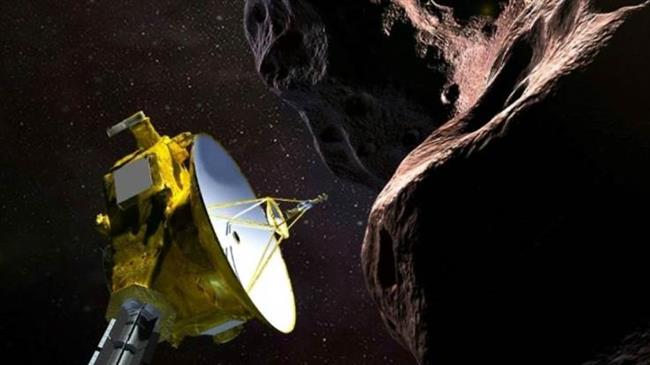NASA spaceship set for New Year flyby of Ultima Thule
A NASA spaceship is zooming toward the farthest, and quite possibly the oldest, cosmic body ever photographed by humankind, a tiny, distant world called Ultima Thule about four billion miles (6.4 billion kilometers) away.
The US space agency will ring in the New Year with a live online broadcast to mark the historic flyby of the mysterious object in a dark and frigid region of space known as the Kuiper Belt at 12:33 am January 1 (0533 GMT Tuesday).
A guitar anthem recorded by legendary Queen guitarist Brian May -- who also holds an advanced degree in astrophysics -- will be released just after midnight to accompany a video simulation of the flyby, as NASA commentators describe the close pass on www.nasa.gov/nasalive.
Real-time video of the actual flyby is impossible, since it takes more than six hours for a signal sent from Earth to reach the spaceship, named New Horizons, and another six hours for the response to arrive.
But if all goes well, the first images should be in hand by the end of New Year's Day.
"It sounds like science fiction, but it's not," Alan Stern, the lead planetary scientist on the New Horizons mission, wrote in The New York Times on Monday.
He described the New Horizons spaceship as an "amazing piece of American workmanship, operating essentially flawlessly in space for well over a decade."
Its destination, Ultima Thule, "is 17,000 times as far away as the 'giant leap' of Apollo's lunar missions," he added, recalling that December 1968 marks the 50th anniversary of the first time humans ever explored another world, when US astronauts orbited the Moon aboard Apollo 8.
"This week, New Horizons will continue in that legacy," Stern wrote.
"As you celebrate New Year's Day, cast an eye upward and think for a moment about the amazing things our country and our species can do when we set our minds to it."
What does it look like?
Scientists are not sure what Ultima Thule (pronounced TOO-lee) looks like -- whether it is round or oblong or even if it is a single object or a cluster.
It was discovered in 2014 with the help of the Hubble Space Telescope, and is believed to be 12-20 miles in size.
Scientists decided to study it with New Horizons after the spaceship, which launched in 2006, completed its main mission of flying by Pluto in 2015, returning the most detailed images ever taken of the dwarf planet.
"At closest approach we are going to try to image Ultima at three times the resolution we had for Pluto," said Stern during an interview on NASA TV last week.

"If we can accomplish that it will be spectacular."
Hurtling through space at a speed of 32,000 miles (51,500 kilometers) per hour, the spacecraft aims to make its closest approach within 2,200 miles of the surface of Ultima Thule.
The flyby will be fast, at a speed of nine miles (14 kilometers) per second.
Seven instruments on board will record high-resolution images and gather data about its size and composition.
Frontier of planetary science
Ultima Thule is named for a mythical, far-northern island in medieval literature and cartography, according to NASA.
"Ultima Thule means 'beyond Thule' -- beyond the borders of the known world -- symbolizing the exploration of the distant Kuiper Belt and Kuiper Belt objects that New Horizons is performing, something never before done," the US space agency said in a statement.
According to project scientist Hal Weaver of the Johns Hopkins Applied Physics Laboratory, humans didn't even know the Kuiper Belt -- a vast ring of relics from the formation days of the solar system -- existed until the 1990s.
"This is the frontier of planetary science," said Weaver.
"We finally have reached the outskirts of the solar system, these things that have been there since the beginning and have hardly changed -- we think. We will find out."
Despite the partial US government shutdown, sparked by a feud over funding for a border wall with Mexico between President Donald Trump and opposition Democrats, NASA administrator Jim Bridenstine vowed that the US space agency would broadcast the flyby.
Normally, NASA TV and NASA's website would go dark during a government shutdown.
NASA will also provide updates about another spacecraft, called OSIRIS-REx, that will enter orbit around the asteroid Bennu on New Year's Eve, Bridenstine said.
(Source: AFP)
ICC rejects Israel's appeal to invalidate Netanyahu's arrest warrant
Imam Reza (AS) holy shrine begins accepting crypto donations
VIDEO | Newborn deaths surge in Gaza amid siege and maternal malnutrition
VIDEO | Pakistan, China conclude joint counterterrorism drills
Palestinian authorities slam ‘dangerous’ Israeli plan for 9,000 West Bank settler homes
‘Israeli actions, not Iran, fuel anti-Semitism’: Netizens react to Jewish holiday attack in Sydney
Iran opposes Trump's corridor plan for Caucasus: Leader’s aide
VIDEO | Press TV's news headlines












 This makes it easy to access the Press TV website
This makes it easy to access the Press TV website